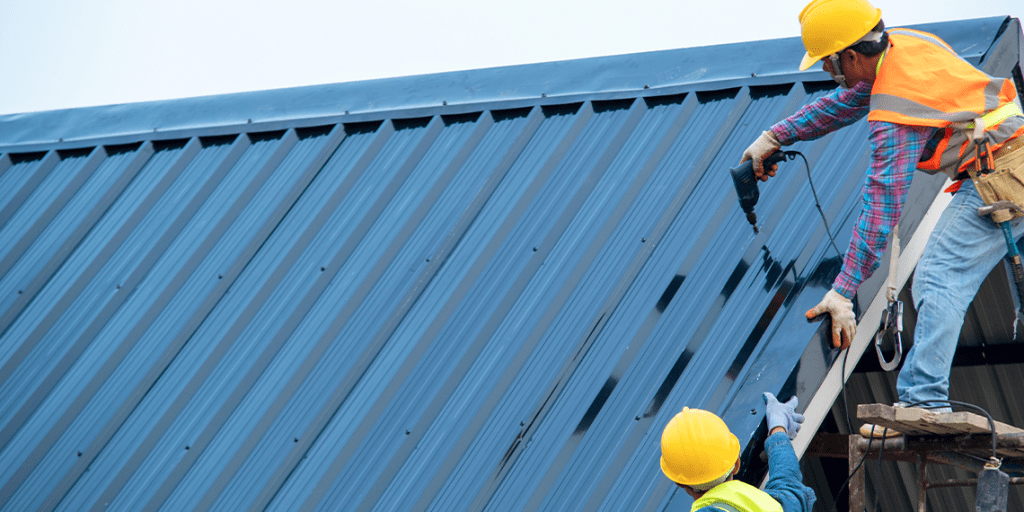Metal roofs are known for their durability, longevity, and energy efficiency, making them a popular choice for homeowners. However, like any roofing material, they require proper maintenance to ensure they remain in excellent condition. This article provides essential metal roof maintenance tips that will help you preserve the integrity and aesthetics of your roof for years to come.

Understanding Metal Roofs
Metal roofs are typically made from materials like steel, aluminum, or copper, offering advantages over traditional asphalt shingles. They can withstand extreme weather conditions, resist fire, and provide excellent insulation. Despite these benefits, regular maintenance is crucial to maximize their lifespan and performance.
Read too: How To Replace Roof Shingles That Blew Off: A Comprehensive Guide
Why Maintenance Matters
Regular maintenance not only helps to prevent minor issues from escalating into major repairs but also extends the lifespan of your roof. Metal roofs can last anywhere from 40 to 70 years with the right care. Neglecting maintenance, on the other hand, can lead to rust, leaks, and other costly problems.
Metal Roof Maintenance Tips
1. Regular Inspections
One of the most important metal roof maintenance tips is to conduct regular inspections. Ideally, you should inspect your roof at least twice a year—once in the spring and once in the fall. Look for:
- Signs of rust or corrosion
- Loose or missing screws and fasteners
- Damaged or loose panels
- Accumulated debris, such as leaves and branches
Addressing these issues early can save you from more extensive repairs down the road.
2. Clean the Roof
Keeping your metal roof clean is essential for its longevity. Debris, dirt, and algae can accumulate and lead to corrosion or other damage. Follow these cleaning tips:
- Use a Soft Brush or Broom: Gently sweep off leaves, twigs, and dirt.
- Wash with Mild Detergent: Use a mixture of mild detergent and water for deeper cleaning. Avoid abrasive cleaners, as they can scratch the metal surface.
- Rinse Thoroughly: After washing, ensure you rinse the roof with clean water to remove any soap residue.
3. Maintain Gutters and Downspouts
Clogged gutters can lead to water pooling on your roof, which can cause rust and leaks. Regularly clean your gutters and downspouts to ensure proper water drainage. Use a ladder safely, and if needed, consider hiring a professional.
4. Address Rust and Corrosion
If you notice rust spots, it’s essential to address them promptly. Here’s how to manage rust:
- Sand the Affected Area: Use sandpaper to remove rust, but be gentle to avoid damaging the surrounding metal.
- Apply a Rust Inhibitor: After sanding, apply a rust-inhibiting primer to prevent further corrosion.
- Repaint: Use a paint specifically designed for metal roofs to protect the surface and improve appearance.
5. Inspect Flashing and Seams
Flashing is critical for preventing leaks around chimneys, vents, and other roof penetrations. Regularly inspect the flashing and seams for signs of wear or damage. If you find any issues:
- Seal Gaps: Use a high-quality sealant to fill any gaps or cracks.
- Replace Damaged Flashing: If the flashing is bent or broken, it should be replaced to ensure a proper seal.
6. Check for Loose Fasteners
Over time, the screws and fasteners that hold your metal panels in place can become loose. Periodically check for loose screws and tighten them as necessary. Use the appropriate tool for the type of fastener to avoid stripping them.
7. Trim Overhanging Branches
Overhanging branches can damage your metal roof and create debris buildup. Regularly trim trees and branches that hang close to your roof to prevent potential damage and reduce maintenance needs.
8. Ensure Proper Insulation and Ventilation
Proper insulation and ventilation are crucial for preventing moisture buildup, which can lead to rust and corrosion. Ensure your attic is adequately ventilated and insulated to maintain optimal temperature and humidity levels.
9. Address Leaks Immediately
If you notice any signs of leaks inside your home, such as water stains or mold, address them immediately. Locate the source of the leak, which may involve inspecting your roof and checking for damaged panels, loose fasteners, or compromised flashing.
10. Hire a Professional for Major Repairs
While regular maintenance can often be handled by homeowners, major repairs or extensive inspections should be left to professionals. If you encounter significant issues during your inspections, hiring a qualified roofing contractor is essential to ensure the job is done correctly.
Conclusion
Maintaining your metal roof is key to ensuring its longevity and performance. By following these metal roof maintenance tips, you can help prevent common issues, save on costly repairs, and enjoy the many benefits that metal roofing offers. Regular inspections, cleaning, and prompt repairs are the foundation of effective maintenance, ensuring your roof remains in top shape for decades.



Leave a Reply